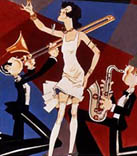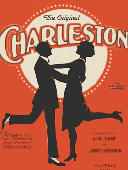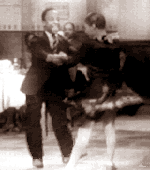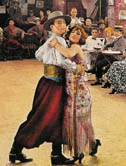Dances of the Jazz Age
Dances of the Jazz Age
Within weeks of the Armistice, both Europeans and Americans were dancing again with renewed enthusiasm. In
Paris, the wartime ban on public dancing was still in effect at the end of 1918, but that didn't stop the
French from dancing. Many balls were given by the various regiments, with even more "private" tea dances
held by the numerous dance teachers. By 1919 dancing in Paris had fully returned to its pre-war frenzy. The
Dancing Times reported that Parisians "apparently cannot take a meal or watch a play through without
breaking off for a round or two of dancing."
During the pre-war Ragtime Era, many young Americans had been chastised by their elders for a number of
violations against decency, including using slang, dancing low-class dances, and enjoying syncopated music
with African American influences. Progressive women were especially criticized, for abandoning the corset, wearing
shorter skirts that exposed their ankles, cutting their hair short, and leaving the "separate sphere" of
their domestic domain to be socially and politically active in the public arena. As in the later transition from the 1950s
to 1960s, this repression led to a backlash.

During the Roaring Twenties young Americans responded to this criticism by expanding on all of these "violations,"
with more outrageous slang, jazzier music and dance, shorter and flimsier dresses and shorter hair. And
the efforts of the Suffragettes paid off when the Nineteenth Amendment, granting women the right to vote,
was ratified in 1920. The separate spheres of the 19th century had been broken and the Flapper redefined
modern womanhood.
On the dance floor, the Grizzly Bear, Turkey Trot and One-Step weren't merely ten years old; they were from
an entire era ago — before the war, and thus were out of fashion. The newer Fox-Trot had never caught on, having
been introduced only months before the war started, so the Fox-Trot escaped the pre-war stigma and became the favorite "new" dance of
1920. But most dancers still loved the simplicity of the One-Step. In other words, they liked the dance but
not the old-fashioned name, so many continued to dance the One-Step but called it the fashionable new name,
Fox-Trot, much to the annoyance of dance teachers. Music publishers confused the issue further by publishing
one-steps, true foxtrots and even tangos as "Fox-Trots" in order to sell more copies.

Early versions of the Charleston had been staged in small theatrical productions but it became the new dance
hit of the Twenties when it accompanied James P. Johnson's song "The Charleston" in the 1923 Broadway musical
Runnin' Wild. The variety of Charleston variations exploded with the advent of Charleston contests,
for both solo dancers and couples. Then as the Charleston craze began to fade, anxious dance teachers hoped
a new fad would revive their business, and thus embraced the newer Black Bottom. But there was more promotional
publicity from the effort than actual social dancing of the Black Bottom.

The African American Texas Tommy had traveled from San Francisco to New York City in 1911. Harlem dancers kept
the essential concept of the Texas Tommy – a turning Two-Step with swingouts releasing the woman to a single
handhold – and simplified the footwork from three different steps to just one. It was renamed Lindy Hop by
"Shorty" George Snowden in 1928, and it was soon captured on film when Snowden, his fellow Savoy Ballroom dancers
and Chick Webb's band performed it for the 1929 sound film After Seben. Harlem's Savoy Ballroom was integrated
throughout it's reign, passing the Lindy Hop on to both black and white dancers, but the Lindy Hop didn't become
widespread until the 1930s.

Other dances in the 1920s: Waltz and tango continued, with slow waltz becoming a new trend, and exhibition tango adopting a more
"gaucho" style under the influence of Rudolph Valentino. The Foxtrot became smoother than the trotted ragtime version,
or could be bounced even more vigorously, becoming the Toddle. The
Brazilian Samba was introduced in Paris in 1922, then spread. Blues expanded from a sidenote in 1912 to a major
influence in American music during the twenties.
The Wall Street Crash of 1929 ended the Jazz Age, as The Great Depression set in. Dancing continued, with notable
inspirations on the Silver Screen. Dance marathons, continuing from the 1920s, now became a hopeful step up for financially
struggling dancers in the early 1930s. Then by 1936 dancers were ready to cut loose again, with the new hits of
the Shag, Big Apple and the late blossoming of Lindy Hop and jitterbug.
— Richard Powers